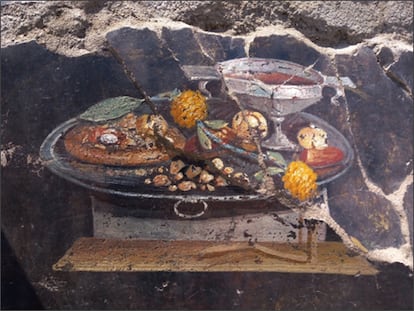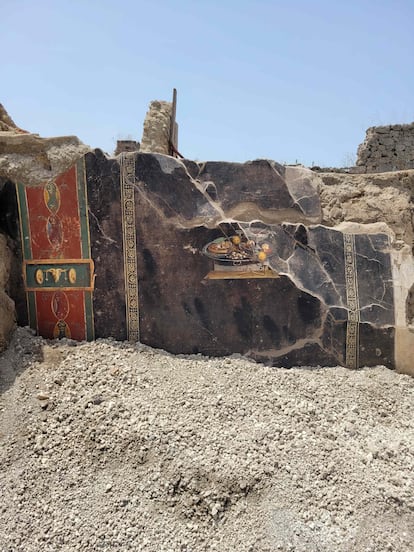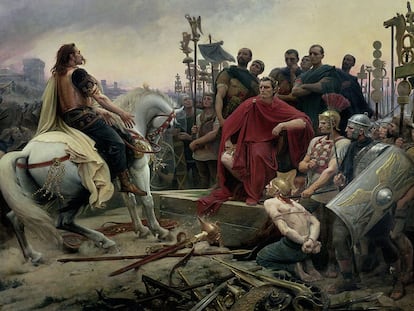A possible precursor of modern pizza has been discovered in Pompeii
A fresco depicting a still life, recently found in the ancient Roman city, includes a representation reminiscent of this staple of Italian cuisine

Pompeii never ceases to amaze. Two millennia after the eruption of Vesuvius that reduced it to ashes, the time machine that the devastated old city has become is still running at full capacity. This archaeological site on the shores of the Gulf of Naples continues to be an impressive window into the daily life of the ancient Romans; now, archaeologists excavating in a new area of the city ravaged by the volcano in the year 79 AD have discovered a fresco representing a still life that includes a dish that looks very similar to what we know today as pizza.
The experts who are analyzing the artwork point out that it cannot really be a depiction of this Italian delicacy – whose exact origin is unknown and which was declared Intangible Heritage of Humanity in 2017 – since the most important ingredients, tomato and mozzarella, are missing.
However, it could be an antecedent of this modern dish. As the people in charge of the Pompeii Archaeological Park point out, in the images that were found on the walls of an ancient Pompeian house, together with a goblet of wine on a silver tray, appears a focaccia, a type of flatbread that serves as a base for various fruits. Archaeologists also identified a pomegranate and some date-like fruits, seasoned with spices or a kind of pesto (moretum, in Latin), depicted with yellowish and ocher dots. In addition, the tray has some dried fruits and yellow madrone fruits.

This type of iconography, known in antiquity as xenia, was inspired by the “hospitality gifts” that used to be offered to guests according to a Greek tradition dating back to the Hellenistic period (3rd-1st centuries BC). The size of the tray, designed to carry large amounts of food, is another example of this custom, to which there are numerous references in classical literature. As the 1st century BC Roman writer Vitruvius explains, “when the Greeks became more refined and their living conditions more opulent, they created small guest apartments inside their homes,” to which they used to send, after their first dinner together, “chickens, eggs, vegetables, fruits and other local products,” to make visitors feel at home.
According to experts, devoting the walls of one’s own home to these representations, so often mentioned in ancient books, was perceived as a symbol of the refinement (not only culinary, but also literary and artistic) of the host. In some cases, such as the recently discovered still life, some of the higher quality paintings were in fact much more expensive than the items that were depicted on them.
Although in the cities that were buried by the Vesuvius (Pompeii, Herculaneum and Stabia) some three hundred representations of this type have already been found, related to both the sacred and the hospitality contexts, this new fresco stands out due to its “remarkable quality of execution,” according to the archaeologists.
“In addition to the precise identification of the food that is represented, we find in this fresco some themes from the Hellenistic period, elaborated later by authors from the Roman-imperial period such as Virgil, Martial and Philostratus. I think of the contrast between a frugal, simple meal, which evokes an area between the bucolic and the sacred, on one hand, and the luxury of silver trays and the refinement of artistic and literary representations,” observed Gabriel Zuchtriegel, director of the Pompeii Archaeological Park, adding, regarding the comparison with today’s pizza: “How can we not think about pizza, which also originated as a poor dish in southern Italy and which has now conquered the world and is also served in star-rated restaurants.”
The fresco was found in the atrium of a house on Insula 10 of Regio IX of the archaeological site, on the border between the excavated part and the unexplored area of the ancient city, still buried under tons of lapilli and ashes. In addition, a bakery – already partially explored between 1888 and 1891 – appeared in an adjoining area and is being studied since January. The partially exposed structures that were excavated in the 19th century already suggested the presence of a large atrium with the classic succession of rooms on the east side and, on the opposite, the entrance to the bakery.
The archaeologists cleaned the atrium of material from the 19th century excavations and the remains of the collapse of the roofs; an arduous, delicate task, as the rubble is mixed with the volcanic material.
A few weeks ago, they also found the skeletons of two adult women and a child who died on the day of the eruption in that same area. Their case is peculiar – like that of other similar ones discovered recently – because they were not directly hit by the pyroclastic material spewing furiously from the volcano, but were suddenly buried while trying to take shelter from the rain of lava, due to the collapse of the rooftops that occurred as a result of the earthquake that accompanied the eruption.
Sign up for our weekly newsletter to get more English-language news coverage from EL PAÍS USA Edition
Tu suscripción se está usando en otro dispositivo
¿Quieres añadir otro usuario a tu suscripción?
Si continúas leyendo en este dispositivo, no se podrá leer en el otro.
FlechaTu suscripción se está usando en otro dispositivo y solo puedes acceder a EL PAÍS desde un dispositivo a la vez.
Si quieres compartir tu cuenta, cambia tu suscripción a la modalidad Premium, así podrás añadir otro usuario. Cada uno accederá con su propia cuenta de email, lo que os permitirá personalizar vuestra experiencia en EL PAÍS.
¿Tienes una suscripción de empresa? Accede aquí para contratar más cuentas.
En el caso de no saber quién está usando tu cuenta, te recomendamos cambiar tu contraseña aquí.
Si decides continuar compartiendo tu cuenta, este mensaje se mostrará en tu dispositivo y en el de la otra persona que está usando tu cuenta de forma indefinida, afectando a tu experiencia de lectura. Puedes consultar aquí los términos y condiciones de la suscripción digital.
More information
Últimas noticias
All the effects of gentrification in one corner of Mexico’s Colonia Roma
Palestinian reporter Youmna El Sayed: ‘My family told me I had to choose between being a journalist or a mother’
The new language of the workplace: Knowing how to ask AI questions is more important than using it
Russell Tovey: ‘I was advised many times not to come out, I don’t think there was many people who’d done that — and I feel really proud that I’m one of those that did’
Most viewed
- The low-cost creative revolution: How technology is making art accessible to everyone
- Christian Louboutin: ‘Young people don’t want to be like their parents. And if their parents wear sneakers, they’re going to look for something else’
- US sanctions against jailed cartel leader ‘El Marro’ highlight Mexico’s lack of control over its prisons
- Liset Menéndez de la Prida, neuroscientist: ‘It’s not normal to constantly seek pleasure; it’s important to be bored, to be calm’
- Cartels in Mexico take a leap forward with narco-drones: ‘It is criminal groups that are leading the innovation race’











































